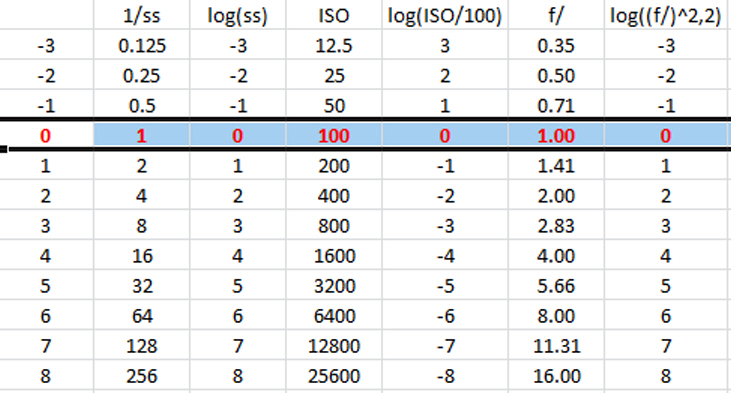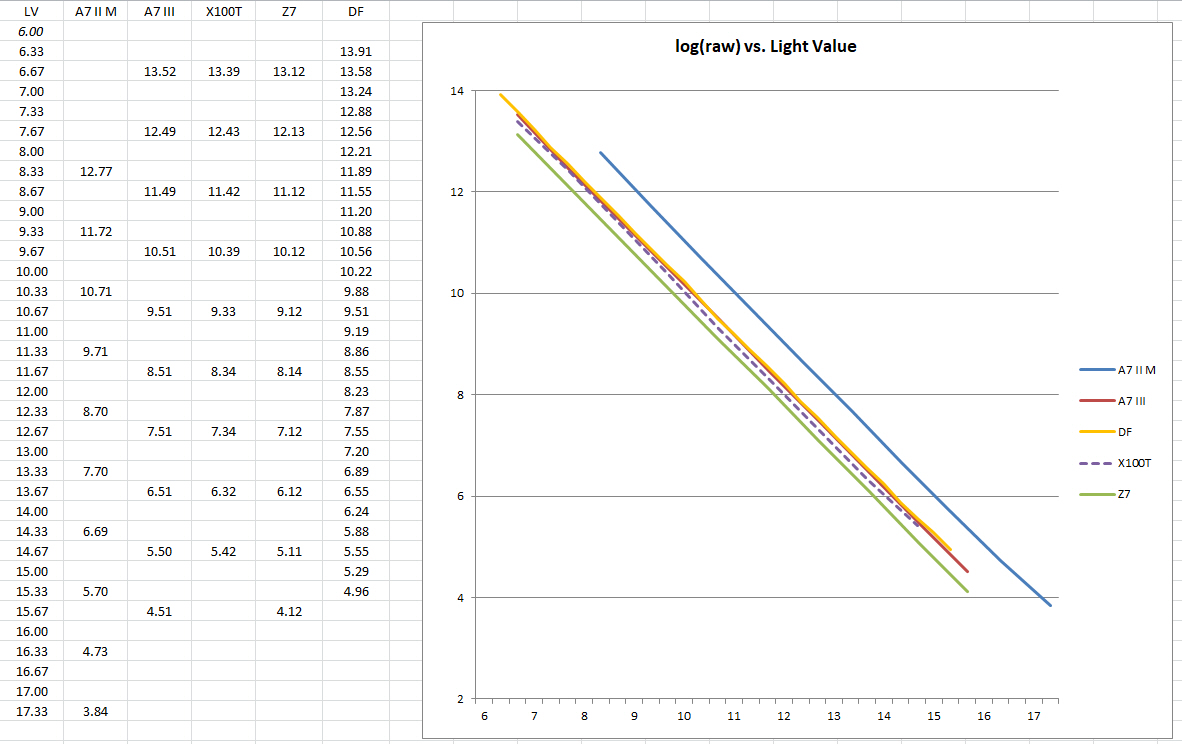Exposure Triangle Spreadsheet Updated
Dec 26, 2023 18:23:25 #
selmslie wrote:
Shutter speed (1/4, 1/8, 1/16, 1/32 ...), aperture... (show quote)
Yes, I completely understand the relationship between ISO (ASA), Shutter Speed, Aperture, and their number series and why. I've known about the ƒ-numbers being multiples of the square root of 2 or approximately 1.414 and why since shortly after starting to do photography in 1978. The Din exposure system is a German Log-based film speed system of x+3 "DIN" = 2x "ASA". ISO uses both numbers. I learned how to use Exposure meters because I do think in "Stops". I know there are Light Meters that measure Lux, Ft-Candles and all sorts of weird units. On a daily basis I don't need to do more than a little math in my head as my digital cameras have extremely accurate metering systems. Film is harder to work with. I usually shoot close-ups and Macro with full manual Exposure and Focus. For many other uses I will use AE & AF. I thought I would play around with your Spread-sheet for fun and to occasionally check my calculations. As I said before, I think I have it figured out now with you further explanations.
Dec 26, 2023 19:05:25 #
Dec 26, 2023 19:09:47 #
selmslie wrote:
Try each of your lenses spot metered on a calibrated target at the same f-stop. How much does the camera’s exposure vary? I did that and only found a couple of outliers.
I absolutely could care less.
I take photos for fun and the math behind the photo is meaningless.
My concern is only the final result that I get with the camera.
All these tests people do means nothing to me and is quite boring.
My camera works great, if there is a shot I don't like then with the magic of digital I can see it immediately and make a change in setting or composition or whatever I want. NO math involved but a highly calibrated eye.

Dec 26, 2023 21:07:40 #
Architect1776 wrote:
I absolutely could care less. br I take photos for... (show quote)
So why bother to post here?

Dec 27, 2023 03:34:31 #
Orphoto
Loc: Oregon
I might not have tried hard enough to understand the point, but fail to appreciate the value or necessity of the spreadsheet. People who have been doing this for a while are fluent with the 3 scales involved and if needed, can count on their fingers to achieve shifts in exposure of x number of stops. Back in the day when my digital spotmeter reported values in EVs, that number by itself mattered little until translated into some combination of the same 3 scales. Now that the meter is long gone, no longer deal with EVs directly at all.
Dec 27, 2023 05:45:52 #
Orphoto wrote:
I might not have tried hard enough to understand the point, but fail to appreciate the value or necessity of the spreadsheet. ...
If you don't appreciate the math behind photography then don't bother with the following illustrations.
For everyone else:


Base 2 log

Dec 27, 2023 08:29:58 #
selmslie wrote:
The original spreadsheet let you calculate the Lig... (show quote)
I do appreciate your effort to address this . . . .
Dec 27, 2023 08:46:13 #
Jimmy T wrote:
I do appreciate your effort to address this . . . .

Dec 27, 2023 10:02:35 #
selmslie wrote:
If you don't appreciate the math behind photography then don't bother with the following illustrations.
For everyone else:
For everyone else:
I appreciate your effort and spreadsheet, that is why I asked so many questions. I wanted to understand and learn something. Do I need to use it, no. I have several exposure meters and my digital cameras do a great job with out thinking about the Exposure Triangle. I know what is appropriate and set the F-stop for DoF and go from there.
Dec 27, 2023 10:54:24 #
selmslie wrote:
So why bother to post here? 

Ask yourself that same question.
You just troll your foolish BS pretending it relates to actual photography, perhaps to show what a Great Photographer you are ?
Having reviewed your Gallery postings its hugely obvious that triangles and spread sheets are NOT the path to great photos.
Dec 27, 2023 10:59:28 #
Architect1776 wrote:
I absolutely could care less. br I take photos for... (show quote)
These tests mean nothing to me either. But, photography is a hobby for all but a few of us on this forum. Many of us are retired and pursue this hobby as we see fit for our own purposes. For some that means buying (and selling) a lot of gear, for others it is the art, for some it is travel, for some it is diving deep into Photoshop, for some it is minimalism and for some it means creating and understanding a spreadsheet on the exposure triangle. The mere pursuit of this data is interesting to some and is an intellectual exercise in of itself. It is no different than a crossword puzzle, writing poetry, or simply learning something new for the sake of learning. Boring to you (and irrelevant to me) is not boring to the OP and the posters on this topic. Perhaps look at things from their perspective.
Dec 27, 2023 11:15:57 #
lamiaceae wrote:
I appreciate your effort and spreadsheet, that is why I asked so many questions. I wanted to understand and learn something. Do I need to use it, no. I have several exposure meters and my digital cameras do a great job with out thinking about the Exposure Triangle. I know what is appropriate and set the F-stop for DoF and go from there.
It's mainly a research aid for me, not for normal photography.
I use a calibrated display (Datacolor Spyder X) to display a target, a white background of an empty file folder. When metered at EC+0 it will capture an image at the camera's default for middle gray. For the Z7 and A7 III that works out to LV 10, regardless of the aperture or ISO. For the Fuji X100T it's LV 9.67.
My A7 II behaved differently (LV 11) even before I had the Bayer array removed. But now that the Bayer array is gone the target meters at LV 12. Although the base ISO setting is 100 it always recorded about a stop darker in the raw file and the camera's JPEG than my other cameras. At EC+1 I can still get the camera to behave as it did when the Bayer array was still there.
At EC+3 and base ISO my cameras manage to use nearly all of the sensor's full well capacity. By then they will show highlight or zebra warnings.
What I have been able to determine from a lot of testing is that all digital cameras conform to the exposure triangle principles in that throughout their normal ISO range what is recorded in the raw file is almost perfectly linear. Only the X100T deviates a little because its shutter is not as precise, its analog range is limited to ISO 200 to 2000.

Dec 27, 2023 11:18:18 #
a6k
Loc: Detroit & Sanibel
User ID wrote:
Ask yourself that same question.
You just troll your foolish BS pretending it relates to actual photography, perhaps to show what a Great Photographer you are ?
Having reviewed your Gallery postings its hugely obvious that triangles and spread sheets are NOT the path to great photos.
You just troll your foolish BS pretending it relates to actual photography, perhaps to show what a Great Photographer you are ?
Having reviewed your Gallery postings its hugely obvious that triangles and spread sheets are NOT the path to great photos.
Name calling is not appropriate. Also your final thought would negate the Zone system. The path needs multiple lanes.
Dec 27, 2023 11:23:12 #
User ID wrote:
Ask yourself that same question.
You just troll your foolish BS pretending it relates to actual photography, perhaps to show what a Great Photographer you are ?
Having reviewed your Gallery postings its hugely obvious that triangles and spread sheets are NOT the path to great photos.
You just troll your foolish BS pretending it relates to actual photography, perhaps to show what a Great Photographer you are ?
Having reviewed your Gallery postings its hugely obvious that triangles and spread sheets are NOT the path to great photos.
Don't limit yourself to my Gallery postings. Take a look at the body of work in the links under my signature:
http://www.scotty-elmslie.com
https://fineartamerica.com/profiles/scotty-elmslie?tab=artworkgalleries
Where do you post your best work? Show us where to find it. Isn't it good enough to share?
Dec 27, 2023 12:56:30 #
Architect1776 wrote:
I absolutely could care less. br I take photos for... (show quote)
And we could care less that you care less.
If you want to reply, then register here. Registration is free and your account is created instantly, so you can post right away.







